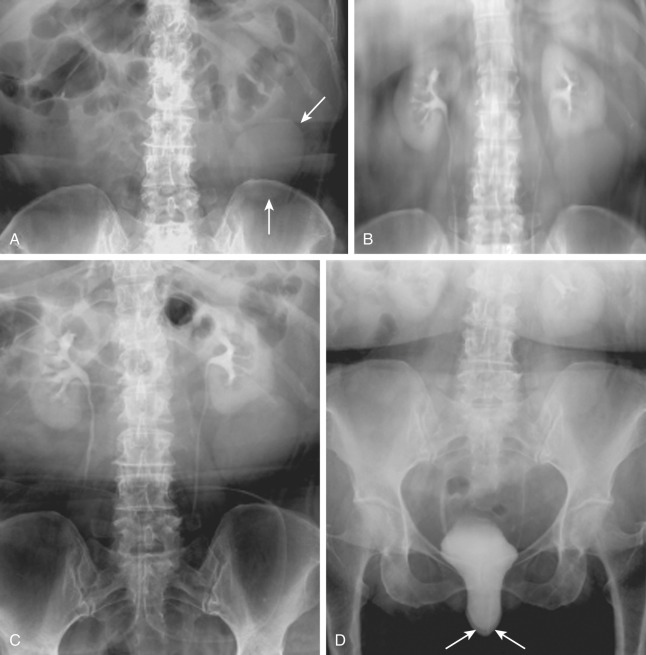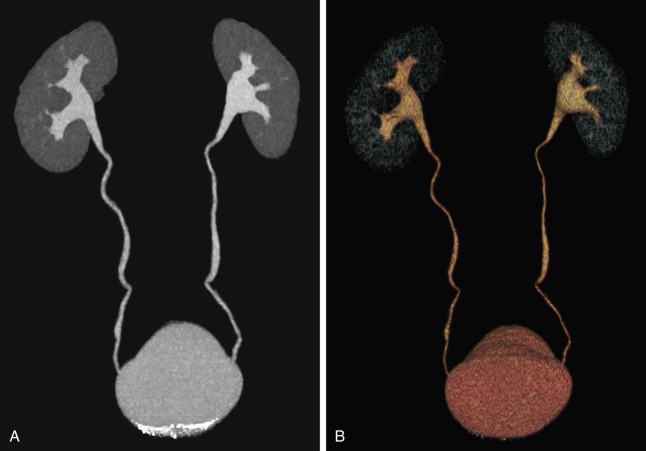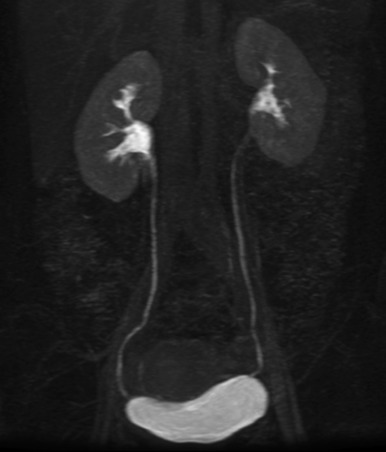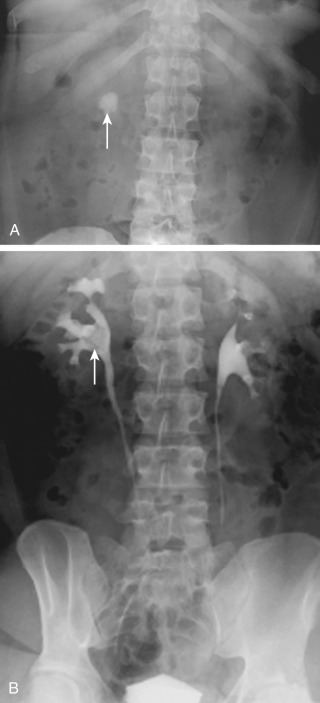Physical Address
304 North Cardinal St.
Dorchester Center, MA 02124
A urogram is an imaging study that is used to evaluate both the anatomy and physiology of the urinary tract. The major indications for urography are to evaluate patients with gross or microscopic hematuria, history of urothelial carcinoma, urinary tract stones, and suspected post-surgical or post-traumatic ureteral leaks.
There are three techniques for performing urography: intravenous urography (IVU), computed tomographic urography (CTU), and magnetic resonance urography (MRU). These are described in greater detail below.
IVU is a radiographic technique that provides anatomic and functional information about the urinary tract but has now largely been replaced by CTU for most indications. Radiographic contrast material is administered intravenously, and a series of images are obtained to show the kidneys, ureters, and urinary bladder ( Figure 33-1 ). Other synonyms used for this study are intravenous pyelography (IVP) and excretory urography . Although IVP is probably the most commonly used term for this technique, it is inaccurate because pyelography literally means “a study of the renal pelvis.” IVU provides far more information than just an anatomic depiction of the renal pelvis alone. The term pyelography is reserved for retrograde studies in which only the collecting system is visualized.

Thin-section multiplanar computed tomography (CT) is used to image the entire urinary tract in multiple phases. Initially, unenhanced images are obtained through the abdomen and pelvis to assess for calculi and calcifications. After a rapid infusion of intravenous contrast material, images through the kidneys are acquired in the nephrographic phase to assess for renal parenchymal abnormalities and renal masses, such as renal cell carcinoma (please refer to Chapter 35 for more details regarding the different phases of contrast enhancement in which the kidneys are examined). After a 10- to 12-minute delay from the start of contrast injection, coronal and sagittal reformatted images are created from image acquisition during the excretory phase, which provide “IVU-like images” of the collecting systems, ureters, and bladders ( Figure 33-2 ). There are many techniques to perform CTU, with institutional variations, such as administration of a diuretic or saline infusion, to optimize distension and opacification of the collecting systems.

MRU uses magnetic resonance imaging (MRI) to evaluate the renal parenchyma and collecting systems for urothelial abnormalities. Intravenous administration of gadolinium-based contrast material as well as a diuretic are utilized to depict the collecting systems and ureters ( Figure 33-3 ). MR images are acquired in axial, coronal, and sagittal planes.

CT and MRI are comparable for evaluation of the renal parenchyma, and for assessment of renal masses. However, the ability of CTU to detect small urothelial lesions is much greater than that of MRU, making it the preferred technique for evaluating the collecting systems and ureters for urothelial neoplasms.
IVU is much less sensitive than either CTU or MRU for detection of renal masses and evaluation of the parenchyma, making it less optimal than CTU or MRU in a patient undergoing evaluation for hematuria. In a patient undergoing evaluation for urothelial tumors, IVU has good sensitivity for depicting urothelial lesions. However, as detailed below, IVU requires a rigorous preprocedure preparation, making it uncomfortable for patients. For these reasons, IVU has ceded ground to CTU for most clinical indications in the evaluation of the urinary tract. It continues to be a valuable technique in evaluating patients postoperatively after urologic procedures, in order to exclude obstruction as a complication of the procedure.
Due to the multiple phases of examination and the thin sections necessary for CTU, radiation exposure is a prime concern; it can range from 15 mSv to much higher. Evolving CT techniques are focused on reducing the radiation exposure for these examinations.
Good-quality IVU requires preprocedural preparation, aimed at cleansing the colon so that overlying bowel contents do not obscure the upper urinary tract. Colon cleansing generally consists of laxatives taken the evening before the study. Patients are also asked to avoid solid food the day before the study and consume a clear liquid diet instead. In emergent situations, such as in the setting of a suspected ureteral leak, the study can be performed without preprocedural preparation, recognizing that the evaluation of the collecting systems for subtle abnormalities may be suboptimal without the bowel preparation. CTU requires neither a laxative preparation nor dietary modifications, making it the preferred technique for evaluation of the urinary tract.
For both CTU and MRU, normal renal function is a necessity. No special preprocedure preparation is required.
CTU and IVU require the administration of an intravenous contrast material and are not performed in patients who have a history of severe adverse reaction to iodinated contrast material (see Chapter 6 for more details).
Patients with renal insufficiency may have further deterioration in renal function after intravenous iodinated contrast administration. IVU and CTU are best avoided in such patients, and alternative imaging techniques are instead used to evaluate the urinary tract.
Pregnancy is a relative contraindication, with the primary concern being radiation exposure to the fetus, particularly in the first and second trimesters of pregnancy. All women of childbearing age are directly questioned to determine the date of the last menstrual period and to ascertain whether the patient could be pregnant. If there is concern, a pregnancy test is obtained before performing the study. If CTU or IVU is unavoidable in a pregnant patient, efforts are made to limit the radiation exposure using the ALARA principle (see Chapter 7 for more details).
Patients taking oral hypoglycemic agents, such as metformin (Glucophage), should stop taking the medication at the time of CTU or IVU and not resume it until renal function has been confirmed as being normal to avoid the risk of lactic acidosis. Current guidelines do not require the patient to stop taking the medication before contrast administration.
MRU does not have the spatial resolution of CTU for detecting small urothelial lesions, thus making it inferior to CTU, IVU, and retrograde pyelography for evaluation of the collecting systems. MRU is a superb technique for delineating an obstructed urinary tract and for evaluating congenital anomalies. It is contraindicated in patients with a prior history of adverse reaction to gadolinium-based contrast material, in pregnant patients, and in patients with general contraindications to MRI, such as when certain metallic or electronic devices are present.
The procedure (see Figure 33-1 ) begins with two radiographs, known as the preliminary or scout images, which are used to examine the soft tissues, bones, and bowel gas pattern. One radiograph is centered over the kidneys, and the second radiograph views the entire abdomen to the level of the pubic symphysis. Scout radiographs are particularly important for detecting radiopaque urinary tract stones because these stones have the same radiographic density as excreted contrast material and are often difficult to visualize when the collecting systems are opacified with contrast ( Figure 33-4 ). In addition to calculi, the scout radiographs are also used to detect renal masses (see Figure 33-1, A ).

The imaging sequence of IVU is aimed at evaluating the renal parenchyma for masses and the collecting systems for urothelial neoplasms and other abnormalities, such as papillary necrosis. Parenchymal evaluation is performed with a series of images called nephrotomograms , in which the x-ray tube moves over the patient in an arc with a fixed focal plane that is in sharp focus (see Figure 33-1, B ). Structures anterior or posterior to the focal point are blurred.
Evaluation of the collecting systems for subtle abnormalities is aided by distention of the collecting systems. This requires compressing the abdomen with inflatable balloons so that the ureters are obstructed (see Figure 33-1, C ). When the compression is released, contrast material floods the ureters, allowing for visualization of the entire length of the ureters. An image is also obtained in the upright position, which is very sensitive for showing low grades of obstruction (see Figure 33-1, D ). An unobstructed collecting system should drain nearly completely on an upright image. Images of the urinary bladder are obtained with the bladder distended and then after the patient voids. The latter image allows for a rough estimate of bladder function and is sensitive for showing bladder masses.
The upper and lower urinary tract of a patient with hematuria should be evaluated for stones, neoplasms, and other abnormalities that may cause hematuria. The upper urinary tract is usually evaluated with CTU for this purpose, as it is much more sensitive than IVU in diagnosing renal parenchymal abnormalities and in detecting small renal masses. The collecting systems are also satisfactorily evaluated with CTU. The urinary bladder is best evaluated with cystoscopy; all imaging studies are much less sensitive in showing pathologic conditions of the bladder compared to direct inspection by cystoscopy.
Become a Clinical Tree membership for Full access and enjoy Unlimited articles
If you are a member. Log in here